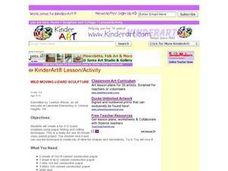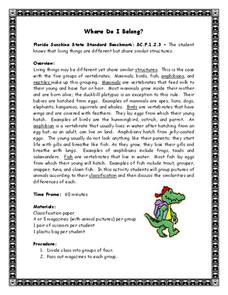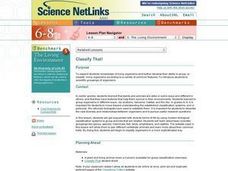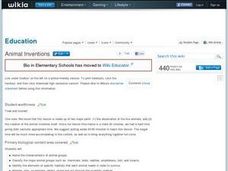Curated OER
Wild Moving Lizard Sculpture
Lizards are amazing! After a instructional activity on reptiles, take a look at this set of instructions. You'll be able to guide your class in making a paper lizard sculpture that moves. This idea also includes variations on the paper...
Curated OER
Crocodile Eyes
Pupils investigate the eyes and eyelids of reptiles and amphibians. In this animal biology lesson plan, students listen to a lecture on the characteristics of amphibians and reptiles and complete a crocodile eyelid activity sheet.
Curated OER
Classifying Vertebrates
Second graders study animal characteristics and classification. In this animal characteristics and classifications lesson, 2nd graders determine how to classify vertebrates which include mammals, reptiles, amphibians, birds, and fish....
Curated OER
No bones About It -A Mosasaur
Learners model a paleontologist's activities. They identify dinosaur bones and reassemble them into a skeleton of an extinct reptile.
Curated OER
Animal Classification
Third graders differentiate between vertebrates and invertebrates, and identify the main characteristics of mammals, fish, reptiles, amphibians, and birds. They sort and categorize different types of balls, discuss the characteristics...
Curated OER
Where Do I Belong?
Fourth graders work in groups. They are given magazines. Students cut pictures of five mamals, five birds, five reptiles, five amphibians, and five fish. They place the pictures in a plastic bag. Students switch bags. They are explained...
Curated OER
Mimics Survive -- Camouflaged Reptiles
Students examine mimicry as a survival strategy in repiles. They examine examples of the Mexican milksnake and the coralsnake in attempt to distinguish the differences in them. They discuss other species that use mimicry.
Curated OER
The Curious Case of Mesosaurus
In this Mesosaurus worksheet, students read 2 short paragraphs about the distribution of the fossils found of this ancient reptile. Students answer 5 questions about Wegener's Theory of continental drift and how it possibly relates to...
Curated OER
Classifying Critters
In this classification worksheet, learners describe the characteristics of the 5 groups of vertebrates and then complete 2 short answer questions.
Curated OER
Prairies
students make booklets about each of the following: reptiles, birds, plants, animals and buffalo. Each was information and contained the facts covered in class. they research one specific area in which they were especially interested....
Curated OER
Classify That!
Students get acquainted with diverse forms of life by using modern biological classification systems to group animals that are related. They explore basic scientific groupings like genus, species, mammals, fish, birds, amphibians, and...
Curated OER
Classify That!
Pupils explore diverse forms of life by using modern biological classification systems to group animals that are related. Students then study basic scientific groupings like genus, species, mammals, fish, birds, amphibians, and...
Curated OER
Plant and Animal Communities
Second graders discuss the six main classes of animals: insects, birds, fish, mammals, amphibians, and reptiles. They complete a variety of activities about animals. They solve animal riddles, categorize toy animals, create an animal...
Curated OER
Sorting and Graphing Animals
Students inquire about animals using SIRS Discoverer or eLibrary Elementary. In this organizing data lesson, students sort pictures of animals in various ways and develop graphs. Students locate a mammal, reptile, fish, insect or bird...
Curated OER
Animal Classification
Young scholars recognize the six groups of animals (Mammals, fish, birds, reptiles, amphibians and arthropods) and their characteristics. In this animal characteristics lesson, students sort animals by their traits. Young scholars cut...
Curated OER
Herps and Humans
Learners compare and contrast the similarities and differences between the internal organs of herps--reptiles and amphibians--and humans.
Curated OER
Examine Your Attitudes
Students complete a survey about their attitudes toward herps--reptiles and amphibians. They compare their findings, tally them, graph them, and administer the survey to others. Later, they create an education campaign to dispel myths...
Curated OER
Steppin' Out: Using Inquiry to Challente Alexander's Stride Analysis
Students distinguish between walking, jogging and running trackways in humans. They analyze the phylogenetic progression of the leg position as described by pace width and angulation, comparing amphibians, reptiles and mammals. Research...
Curated OER
Animal Inventions
Students name the characteristics of animal groups. Students classify the major animal groups such as: mammals, birds, reptiles, amphibians, fish, and insects. They identify the elements of specific habitats that each animal needs in...
Curated OER
NS 6: Monerans, Viruses
Students compare the structures and functions of viruses and bacteria relating their impact on other organisms. They review the main vertebrate groups. Students are describing the characteristics of the main group of vertebrates: ...
Curated OER
What's a Mammal?
Students research his or her assigned mammal using print and online resources. In this mammals research lesson, students discover mammals have certain traits that distinguish them from animals in other classes, such as fish, reptiles,...
Curated OER
The Animal Kingdom of Vertebrates
Seventh graders classify fish according to their characteristics. In this classification lesson students learn how to group animals including birds, reptiles and amphibians.
Curated OER
Where Do All the Animals Live?
Students study animal habitats and make a poster showing two animals, two birds, and two reptiles in their habitats.
Curated OER
Toadstones, Snake Gods, and Divining Turtles
Young scholars research facts about herps--reptiles and amphibians. They choose one or more facts to illustrate and create a drawing to be displayed.
Other popular searches
- Reptiles and Amphibians
- Reptiles Worksheets
- Reptiles Life Cycles
- Reptiles Hands on Activities
- Reptiles Amphibians
- Amphibians and Reptiles K 2
- Reptiles & Amphibians
- Marine Reptiles
- Reptiles Lesson Plans
- Reptiles Introduction
- Collections on Reptiles
- Amphibians and Reptiles K

























